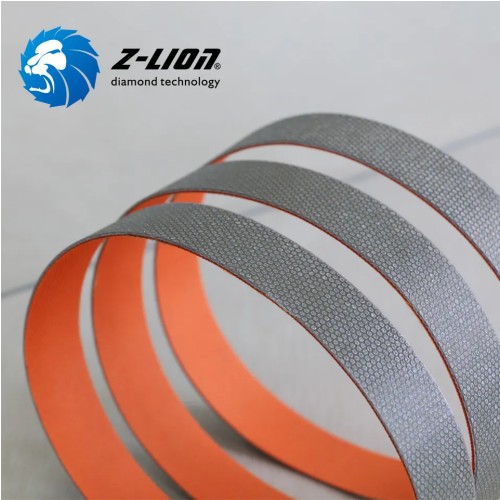
What are the advantages of diamond belt grinding?
Diamond belt grinding is a versatile and efficient method for machining workpieces with specific requirements on shape, surface quality, and precision. This technology is not limited to ordinary flat surfaces, but can also easily handle inner and outer round surfaces. In addition, it excels at machining large or irregular parts that require excellent surface quality and precise dimensions. The use of diamond abrasives in the belt ensures excellent cutting performance and durability.
Diamond abrasive belts are an essential tool in the surface finishing industry, capable of delivering excellent results on a wide variety of materials. From steel plates to ceramic plates, from particle boards to aerospace appliances, diamond abrasive belts provide high precision and low roughness during surface finishing. The versatility of diamond abrasive belts extends to applications in shipbuilding and nuclear physics research equipment. They are designed to provide precision machining of discontinuous surfaces such as those found in engine transmission housings. By using a wide abrasive belt, the grinding process produces a smooth surface that provides better sealing properties than traditional milling methods. With diamond abrasive belts, manufacturers and industries can achieve the surface quality and precision their products require. Whether shaping metal shapes, fine-tuning ceramic plates, or ensuring the perfect finish on insulating materials, diamond abrasive belts are indispensable. Their ability to provide high precision, low roughness and enhanced performance makes them a versatile and efficient choice for surface preparation.
Precisely creating smooth surfaces and polishing interior fillets requires advanced tools and techniques. Thankfully, the flexibility of diamond belts makes this once-difficult task much easier. Diamond belts are designed to handle complex surfaces with ease. They can efficiently machine a wide variety of materials, including tough metals such as aircraft engine blades and steam turbine blades. Even everyday items such as sailboat blades, spotlight bowls, reflectors, cutlery, handles, and water heaters can benefit from using high-quality abrasive belts. A significant advantage of diamond abrasive belts is the ability to polish internal corners with radii of curvature as small as 3 mm. This level of precision ensures that even the smallest details of curved workpieces are expertly polished for a flawless finish. With the reliability and versatility of diamond abrasive belts, manufacturers can tackle the most challenging form grinding tasks with confidence. These conveyor belts not only simplify the process but also deliver excellent results, consistently meeting the high standards required by various industries. So whether you are in the aerospace sector, the power generation industry, or simply looking for a high-quality surface finish for your everyday products, diamond belts are the solution of choice for form grinding of curved workpieces. Their flexibility and ability to handle complex surfaces make them indispensable tools for achieving perfection in polishing and grinding applications.
In modern industry, the use of abrasive belts can efficiently achieve external cylindrical grinding and internal grinding of workpieces with large length-to-diameter ratios. For the external cylindrical polishing of large axial workpieces with a high aspect ratio, an abrasive belt grinding unit can be installed on the standard equipment. This allows efficient grinding and polishing of the outer surface of the workpiece, ensuring a smooth and precise finish. This method is often used for machining large generator rotors, drums, paper dryers, and other cylindrical workpieces. Abrasive belts are also very effective for internal polishing of plumbing workpieces. The inner surface of oil pipelines, pressure vessels, and other parts can be precisely processed by using a special abrasive belt grinder. This ensures high-quality surfaces and proper functionality of the components. There are several advantages to using abrasive belts for circular polishing. They provide flexibility, allowing the machining of different workpiece sizes and shapes. They are also durable and can withstand the rigors of industrial grinding. Additionally, abrasive belts are available in a variety of grit sizes to achieve different levels of surface smoothness. In general, it is a convenient and efficient solution in modern industry to use abrasive belts to perform internal and external polishing of workpieces with relatively large lengths and diameters. It ensures a high-quality surface finish and is capable of high-volume machining of a wide variety of cylindrical components.
A high-quality finish is ensured by providing consistent grinding conditions across the entire width of the strip without risk of excessive localized force or stress deformation. Continuous abrasive belt polishing is especially suitable for surface strips made of alloys such as cold-rolled steel, copper, and aluminum. The processing width can be between 600mm and 2100mm, and the thickness can be between 0.1mm and 2.2mm. The required surface roughness can be achieved in the range of Ra3.2 to 0.1mm. Strip speeds during processing can vary from 3m/min to 80m/min. Planetary belt grinding is an efficient and economical process for coiled wire polishing. This method is commonly used to polish and grind coiled wire made of materials such as stainless steel or other alloys. The wire polishing diameter can range from 0.8mm to 20mm, and the continuous running speed can be set between 6m/min and 150m/min. By utilizing broadband grinding and planetary belt grinding techniques, metal strips, and wire can be efficiently and precisely polished continuously to meet the surface finish requirements required for a variety of industrial applications.
Belt grinding equipment comes in a variety of forms to suit different applications. Here are some examples of general-purpose belt-grinding equipment:
Small Portable Belt Sander: A compact, hand-held machine that is convenient for small-scale grinding tasks or working in confined spaces.
Belt Grinder: This refers to a standard-size belt grinder suitable for many grinding applications. It often has adjustable speeds and different belt sizes for versatility.
Benchtop belt sander: Similar to a belt sander, but designed for use on a tabletop or workbench. It is typically used for light grinding and polishing tasks.
Large Belt Grinders: Heavy-duty, high-powered machines for demanding grinding applications. It can handle large workpieces and remove material quickly.
Flat Belt Grinder: Designed for flat grinding, this machine excels at removing stock and producing a smooth finish on flat surfaces.
Internal abrasive belt grinder: used for grinding the inner surface of pipes, cylinders, or other hollow workpieces. It enables efficient grinding and deburring of inner surfaces.
In addition to general-purpose equipment, there are also specialized belt grinders for specific applications: Camshaft belt profile grinders, industrial oil tank abrasive belt polishing machines, car tire rim end face belt polishers, motorcycle fuel tank abrasive belt polishers, and special stainless steel pot liners.
These purpose-built belt grinders meet the needs of specific industries and applications, providing efficient and precise grinding solutions.

-
Online service
-
Official wechat
account
-
QQ:40933769
-
E-mail:
sales@z-lion.com
Online service
Please feel free to give your inquiry in the form below. We will reply you in 24 hours.

